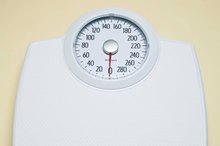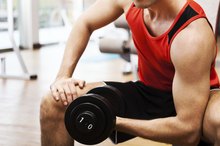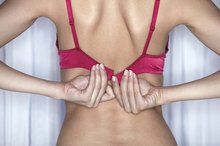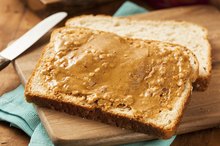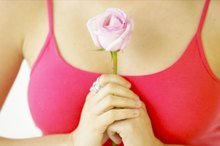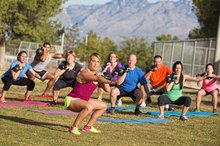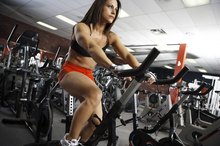Can You Increase Breast Size Naturally by Exercising and Eating?
Some women consider their breasts one of their best features. Others, however, may not be satisfied with their breast size and wonder if they can increase their breast size. Home remedies including diet, exercise and nutrition supplements are touted as a natural way to increase breast size. However, breast size is primarily influenced by genetics and body weight, with breast shape and position also being affected by age and breastfeeding history. While certain exercises can help build muscle under the breasts, there is little women can do to increase breast size.
If you are experiencing serious medical symptoms, seek emergency treatment immediately.
Understand breast anatomy and physiology. According to Johns Hopkins Medicine, breasts are comprised of both fat and breast tissue -- the lobules and ducts that kick into action during lactation 1. In adults, any permanent increase in breast size is often related to fat accumulation in the breast. Temporary increase in breast size may be noticed as part of the monthly menstrual cycle, related to fluctuations of the hormones estrogen and progesterone, and breast size increases during pregnancy and lactation to prepare for milk production. After menopause, reductions in estrogen causes the breast tissue to shrink and lose shape. While there are no muscles in the breasts themselves, the American College of Sports Medicine outlines that increasing pectoral muscles may cause the breasts to appear slightly larger, though any increase is typically quite negligible.
How to Get a Flat Stomach and Bigger Breasts
Learn More
Learn more about calorie balance. According to the Centers for Disease Control and Prevention, calorie balance refers to the number of calories that you are eating, versus the number of calories that your body uses to function 7. Consuming more calories than your body uses is a way to gain weight, and sometimes touted as a way to increase breast size. This will lead to an increase in body fat, but it's not possible to target these fat deposits in the breasts only. Instead, individuals who increase their caloric intake will likely see small increases in fat deposits throughout their body. Furthermore, gaining weight can increase the risk of a number of serious health conditions, including diabetes, high blood pressure and some types of cancer. Because of these risks, the American Council on Exercise strongly discourages women to gain weight solely in an attempt to increase the size of their breasts 345.
Incorporate a regular resistance training routine. While lifting weights will not promote breast growth, it can increase the size of the underlying pectoral muscles. While this may make the chest appear slightly larger, any impact on breast size is negligible. However, toning and staying fit can do wonders to improve healthy, self-esteem and body image. For best results, the American College of Sports Medicine encourages individuals to perform strength training exercises that target the pectoral muscles -- like pushups, chest flyes and chest presses -- two or three times per week 2. Perform two to three sets of 10 to 15 repetitions of the exercise for optimal results.
Reviewed by: Kay Peck, MPH, RD
Related Articles
References
- Johns Hopkins Medicine: Normal Breast Development and Changes
- ACSM's Resource Manual for Exercise Testing and Prescription; American College of Sports Medicine
- American Council on Exercise: Push-Up
- American Council on Exercise: Lying Dumbbell Pec Fly
- American Council on Exercise: Dumbbell Bench Press
- Nutrition Therapy and Pathophysiology; Marcia Nelms, Kathryn Sucher and Sara Long
- Centers for Disease Control and Prevention: Caloric Balance
- ACE's Personal Trainer Manual: American Council on Exercise
- Winocour S, Lemaine V. Hypoplastic Breast Anomalies in the Female Adolescent Breast. Semin Plast Surg. 2013;27(1):42–48. doi:10.1055/s-0033-1343996
- Cruz NI. Breast Asymmetry in Women Requesting Plastic Surgery of the Breast. P R Health Sci J. 2018;37(4):230‐238.
- Chen JH, Chan S, Yeh DC, Fwu PT, Lin M, Su MY. Response of bilateral breasts to the endogenous hormonal fluctuation in a menstrual cycle evaluated using 3D MRI. Magn Reson Imaging. 2013;31(4):538-44. doi:10.1016/j.mri.2012.10.022
- Kader T, Hill P, Rakha EA, Campbell IG, Gorringe KL. Atypical ductal hyperplasia: update on diagnosis, management, and molecular landscape. Breast Cancer Res. 2018;20(1):39. doi:10.1186/s13058-018-0967-1
- Hisham A. Juvenile Breast Hypertrophy: A Successful Breast Reduction of 14.9% Body Weight without Recurrence in a 5-Year Follow-Up. Case Rep Surg. Volume 2017, Article ID 3491012. doi:10.1155/2017/3491012
- Kayar R, Çilengiroğlu ÖV. Breast Volume Asymmetry Value, Ratio, and Cancer Risk. Breast Cancer (Auckl). 2015;9:87-92. doi:10.4137/BCBCR.S32789
- Reilley Ann F. Breast Asymmetry: Classification and Management. Aesthetic Surg J. 2006;26(5):596-600. doi:10.1016/j.asj.2006.07.006
- Cruz NI. Breast Asymmetry in Women Requesting Plastic Surgery of the Breast. PR Health Sci J. 2018 Dec;37(4):230-238.
Writer Bio
Kathryn Vera holds a master's degree in exercise physiology, as well as licensure as a Registered Dietitian. Currently, she works as a Clinical Exercise Physiologist in Cardiac Rehabilitation, where she provides care to patients living with chronic heart disease.



